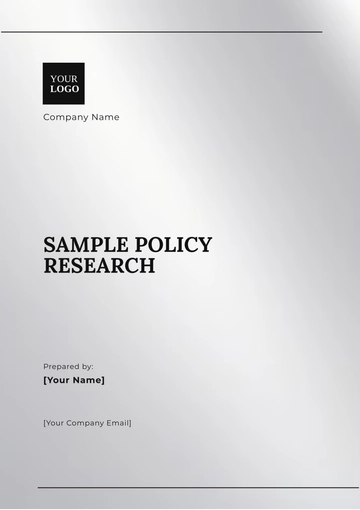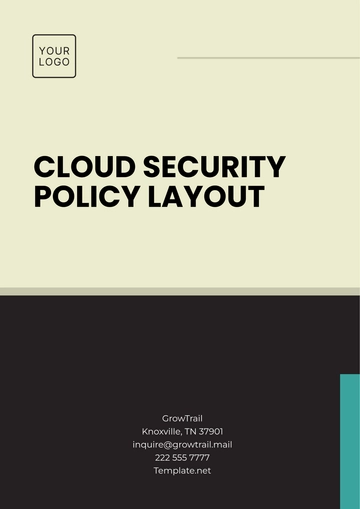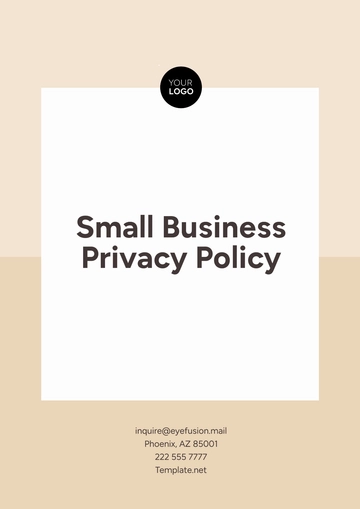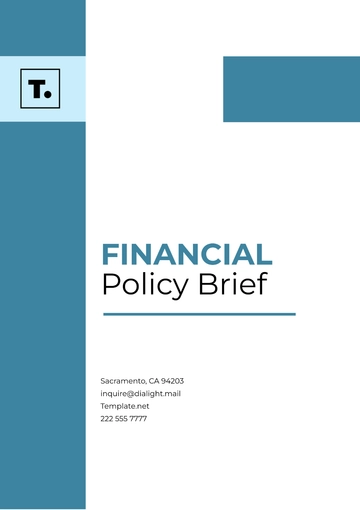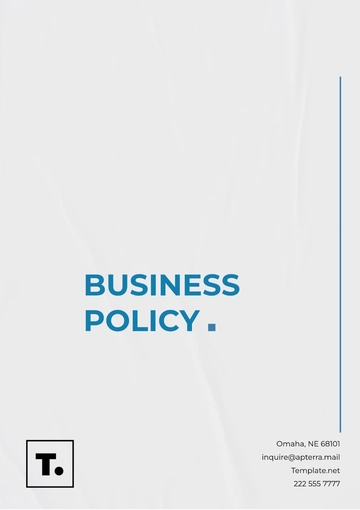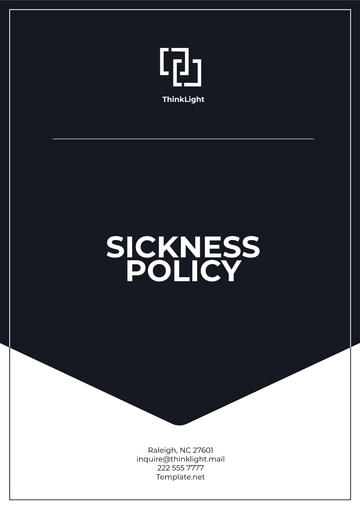Free Agriculture Business Policy

I. Introduction
A. Overview of the Agriculture Business
At [Your Company Name], located in [Your Company Address], we specialize in sustainable agriculture practices aimed at producing high-quality [Crop/Livestock] for local markets. Our farm encompasses [000] acres of fertile land where we integrate modern farming techniques with traditional wisdom to ensure optimal yield and environmental stewardship. By prioritizing soil health, water conservation, and biodiversity, we strive to contribute positively to our community and the environment.
B. Purpose and Objectives of the Policy
The Agriculture Business Policy at [Your Company Name] is designed to uphold our commitment to sustainable farming practices, ensuring the health and safety of our employees, the quality of our products, and compliance with regulatory standards. This policy serves as a comprehensive guide for all aspects of our operations, from production and environmental management to health and safety protocols, fostering transparency and accountability throughout the organization.
II. Governance and Leadership
A. Leadership Structure
Led by [Owner Name], our leadership team at [Your Company Name] oversees day-to-day operations and strategic decision-making. Department heads for production, marketing, and administration ensure clear communication channels and efficient coordination among team members. Regular meetings and performance reviews help maintain alignment with our mission and values, fostering a culture of collaboration and continuous improvement.
B. Roles and Responsibilities
Each member of our team plays a crucial role in maintaining the success and sustainability of [Your Company Name]. From field workers who implement crop management practices to administrative staff who manage logistics and customer relations, every role contributes to our shared goals of producing safe, high-quality agricultural products and maintaining operational efficiency.
C. Decision-Making Processes
At [Your Company Name], decisions are made through a collaborative process that values input from all levels of the organization. Strategic planning sessions and regular feedback mechanisms ensure that decisions align with our long-term objectives of profitability, sustainability, and community engagement. By fostering a culture of transparency and inclusivity, we empower our team to contribute to our shared vision for the future of agriculture.
III. Production Practices
A. Crop Management
Crop Selection and Rotation
At [Your Company Name], crop selection is based on market demand, soil suitability, and rotation schedules designed to optimize soil health and productivity. We rotate crops such as [Crops] to minimize pest and disease pressure while maintaining soil fertility. This practice not only improves yield but also reduces the need for chemical inputs, aligning with our commitment to sustainable agriculture.
Soil Health Management
Soil health is paramount to our farming practices. Through regular soil testing and analysis, we monitor nutrient levels and pH balance to tailor our fertilization and soil amendment strategies. Cover cropping and organic compost application enrich soil structure and promote beneficial microbial activity, enhancing long-term productivity and resilience against environmental stresses.
Irrigation Practices
Our farm employs advanced irrigation techniques such as drip irrigation and precision watering systems to maximize water efficiency. By delivering water directly to the root zone of crops, we minimize water wastage and optimize nutrient uptake. Rainwater harvesting and storage facilities further supplement irrigation needs, ensuring sustainable water management practices throughout the growing season.
B. Livestock Management
Animal Welfare Practices
The well-being of our livestock is a top priority at [Your Company Name]. We provide spacious, well-ventilated housing and outdoor access for animals to exhibit natural behaviors. Regular health assessments and veterinary care ensure disease prevention and promote overall animal health and welfare. Our commitment to ethical treatment extends to humane handling practices and adherence to industry best practices.
Feed and Nutrition Management
Our animals receive a balanced diet tailored to their nutritional needs and growth stages. Feed ingredients are sourced responsibly, prioritizing local and sustainable options whenever possible. Nutrient-dense feed formulations support optimal health and productivity, contributing to the quality of our meat/dairy/eggs and consumer satisfaction.
Disease Prevention and Control
Rigorous biosecurity measures are in place to prevent the introduction and spread of diseases among our livestock. Vaccination protocols are followed according to recommended schedules, and quarantine procedures are implemented for newly arrived animals. By prioritizing preventive measures and prompt veterinary intervention, we maintain a healthy herd/flock and uphold food safety standards.
IV. Environmental Stewardship
A. Conservation Practices
Soil Conservation
To prevent soil erosion and maintain soil health, we implement conservation practices such as contour plowing, terracing, and the use of cover crops. These techniques reduce runoff and soil degradation, preserving the integrity of our land for future generations. No-till and reduced tillage methods further enhance soil structure and organic matter content, supporting sustainable crop production.
Water Conservation
Water conservation is integral to our farming operations. Through efficient irrigation systems and water management practices, we minimize water use while maximizing crop yield. Strategies such as mulching and soil moisture monitoring help retain soil moisture levels, reducing the need for frequent irrigation and conserving precious water resources. By prioritizing water efficiency, we mitigate environmental impact and promote resource sustainability.
Biodiversity Conservation
We recognize the importance of biodiversity in maintaining ecosystem health and resilience. Habitat preservation efforts include maintaining buffer zones, hedgerows, and wildlife corridors to support native flora and fauna. Integrated pest management (IPM) strategies minimize reliance on chemical pesticides, fostering natural predator-prey relationships and enhancing biodiversity on our farm.
B. Sustainable Agriculture Initiatives
Integrated Pest Management (IPM)
Our IPM approach involves proactive monitoring, biological control methods, and targeted pesticide applications as a last resort. By monitoring pest populations and implementing thresholds for intervention, we minimize environmental impact while safeguarding crop health. Crop rotation and resistant varieties are additional tools used to manage pest pressure sustainably, reducing reliance on chemical inputs.
Organic Farming Practices
Certified organic practices are integrated into our farming operations to meet consumer demand for organic products and promote soil health. Soil fertility is enhanced through the use of organic compost, green manures, and crop rotations that maintain nutrient balance. Weed and pest control methods approved for organic production are employed, ensuring compliance with organic certification standards and supporting environmental sustainability.
Energy Efficiency Measures
Energy-efficient technologies and practices are adopted throughout our operations to reduce our carbon footprint. From energy-efficient lighting and equipment to renewable energy sources such as solar panels, we strive to minimize energy consumption and greenhouse gas emissions. Regular energy audits and efficiency upgrades help us identify opportunities for further improvements, ensuring responsible resource management and operational sustainability.
V. Health and Safety
A. Worker Safety
Occupational Health and Safety Standards
At [Your Company Name], the safety and well-being of our employees are non-negotiable. We comply with all relevant occupational health and safety regulations and conduct regular safety audits to identify and mitigate hazards. Training programs cover safe handling of equipment, emergency response procedures, and the proper use of personal protective equipment (PPE) to ensure a safe working environment for all.
Personal Protective Equipment (PPE)
Employees are provided with and trained to use appropriate PPE, including gloves, boots, goggles, and respirators, as required by their tasks. Regular maintenance and replacement of PPE are conducted to ensure effectiveness and comfort. By promoting a culture of safety awareness and compliance, we empower our team to work confidently and securely in all farm operations.
Training and Education Programs
Ongoing training is a cornerstone of our commitment to worker safety. Employees receive comprehensive training sessions on hazard recognition, equipment operation, and emergency preparedness. Regular refresher courses and skill development workshops enhance employee competency and readiness to respond to workplace challenges. By investing in continuous learning and development, we prioritize the safety and professional growth of our workforce.
B. Food Safety and Quality Assurance
Good Agricultural Practices (GAPs)
We adhere to stringent SOPs for crop production, harvest, and post-harvest handling to ensure food safety from farm to table. Field hygiene practices, sanitation protocols, and traceability systems are implemented to minimize contamination risks and maintain product integrity. Regular audits and certifications validate our commitment to GAPs and reassure consumers of the safety and quality of our agricultural products.
Hazard Analysis and Critical Control Points (HACCP)
HACCP principles guide our systematic approach to identifying, preventing, and managing food safety hazards throughout the production process. Critical control points (CCPs) are monitored and verified to prevent microbial, chemical, and physical hazards. Documentation and record-keeping ensure transparency and accountability, enabling prompt corrective actions and continuous improvement in our food safety management system.
Quality Control Procedures
Quality assurance begins with rigorous inspection and testing of our products for freshness, appearance, and nutritional value. Samples are analyzed for pesticide residues, pathogens, and other contaminants to meet strict quality standards. Feedback from customers and market insights inform our quality improvement initiatives, ensuring consistent product excellence and consumer satisfaction.
VI. Financial Management
A. Budgeting and Financial Planning
Financial stability is paramount at [Your Company Name], where meticulous budgeting and financial planning ensure efficient resource allocation. Annual budgets are developed based on projected revenues and expenses, taking into account market trends and production forecasts. Financial goals, including profitability targets and investment priorities, are aligned with our long-term strategic objectives to support sustainable growth and resilience in a dynamic agricultural market.
B. Risk Management and Insurance
Proactive risk management strategies mitigate potential financial risks associated with crop failure, market volatility, and external factors beyond our control. Risk assessments identify vulnerabilities and inform strategies for risk avoidance, reduction, transfer, or acceptance. Comprehensive insurance coverage, including crop insurance and liability insurance, safeguards against unforeseen events, ensuring business continuity and financial protection for [Your Company Name].
C. Financial Reporting and Analysis
Accurate and timely financial reporting is essential for informed decision-making and regulatory compliance. Regular financial statements, balance sheets, and cash flow reports provide transparency on our financial performance and liquidity position. Financial analysis, including variance analysis and key performance indicators (KPIs), guides strategic adjustments and operational improvements, reinforcing our commitment to fiscal responsibility and sustainable profitability.
VII. Marketing and Sales
A. Market Analysis and Trends
Thorough market analysis informs our marketing strategies, identifying consumer preferences, market trends, and competitive dynamics. Market research data guides product positioning, pricing strategies, and market expansion initiatives. By staying attuned to market demands and opportunities, we maximize market penetration and consumer engagement, ensuring our products meet evolving consumer expectations.
B. Product Branding and Promotion
Strong branding distinguishes [Your Company Name] in the marketplace, highlighting our commitment to quality, sustainability, and community values. Brand development strategies emphasize our unique selling propositions and resonate with target audiences. Integrated marketing campaigns leverage digital platforms, social media channels, and community events to build brand awareness, foster customer loyalty, and drive sales growth.
C. Customer Relations and Service
Customer satisfaction is central to our business philosophy at [Your Company Name]. We prioritize transparent communication, responsive service, and personalized customer experiences. Feedback mechanisms, such as customer surveys and direct interactions, enable us to continuously improve our products and services based on customer preferences and expectations. Building long-term relationships with our customers is key to sustaining our market presence and fostering brand advocacy.
VIII. Legal and Regulatory Compliance
A. Compliance with Agricultural Laws and Regulations
At [Your Company Name], we adhere to all local, state, and federal regulations governing agricultural practices, environmental protection, and food safety. Compliance audits and regular updates ensure our operations meet regulatory standards and maintain necessary permits and licenses. Proactive engagement with regulatory agencies and industry associations supports our commitment to legal compliance, sustainability, and responsible stewardship of natural resources.
B. Labor Laws and Employment Practices
Respect for labor laws and fair employment practices is fundamental to our corporate ethos. We uphold employee rights, provide safe working conditions, and adhere to fair wage policies. Human resources policies and training programs promote diversity, equity, and inclusion in the workplace. By fostering a supportive and respectful work environment, we attract and retain skilled talent, driving productivity and organizational success.
C. Environmental Regulations
Environmental stewardship is integral to our operations, guided by compliance with environmental regulations and voluntary sustainability initiatives. We implement best management practices to minimize environmental impact, such as waste reduction, pollution prevention, and habitat conservation. Collaboration with environmental experts and community stakeholders ensures proactive environmental management and continual improvement in our sustainability performance.
IX. Research and Innovation
A. Research and Development Initiatives
Continuous innovation drives our commitment to agricultural excellence and sustainability. Research partnerships with academic institutions and industry experts facilitate ongoing experimentation and technology adoption. Research priorities include crop genetics, sustainable farming methods, and climate-resilient agriculture, aiming to enhance productivity, resource efficiency, and resilience to environmental challenges.
B. Adoption of Technology and Innovation
We embrace cutting-edge technologies and innovative solutions to optimize farm operations and achieve strategic objectives. Precision agriculture tools, IoT (Internet of Things) sensors, and data analytics enhance decision-making accuracy and efficiency. Investments in agritech innovations support real-time monitoring of crop health, soil conditions, and weather patterns, enabling proactive management practices and resource conservation.
C. Continuous Improvement Strategies
A culture of continuous improvement permeates [Your Company Name], driving innovation and operational excellence. Feedback loops and performance metrics guide process enhancements and technology integrations. Employee empowerment through training and skill development fosters a culture of innovation and adaptability. By embracing change and embracing a growth mindset, we strive for continual progress in sustainability, productivity, and customer satisfaction.
X. Crisis Management and Business Continuity
A. Crisis Response Plan
Preparedness is key to effective crisis management at [Your Company Name]. Our crisis response plan outlines protocols for responding to emergencies such as natural disasters, disease outbreaks, or supply chain disruptions. Clear roles and responsibilities, communication strategies, and contingency measures ensure swift and coordinated responses to minimize impact on operations and stakeholders.
B. Business Continuity Strategies
Business continuity planning ensures resilience in the face of adversity. We maintain alternative supply chains, inventory reserves, and strategic partnerships to mitigate operational disruptions. Regular drills and scenario-based exercises test our preparedness and identify areas for improvement. By prioritizing risk mitigation and continuity planning, we safeguard [Your Company Name]'s ability to deliver consistent quality and service to our customers.
C. Communication and Stakeholder Engagement
Transparent communication is essential during crises and everyday operations alike. We maintain open lines of communication with employees, customers, suppliers, and community stakeholders. Timely updates, crisis alerts, and engagement initiatives build trust and reassure stakeholders of our commitment to transparency and accountability. Collaborative partnerships and community outreach efforts strengthen resilience and foster mutual support during challenging times.
XI. Conclusion
A. Summary of Key Policies and Guidelines
The Agriculture Business Policy at [Your Company Name] encompasses comprehensive guidelines and standards for sustainable agriculture, safety, quality, and compliance. It reflects our dedication to ethical practices, innovation, and community stewardship. By adhering to these policies, we uphold our commitment to excellence and sustainability in every aspect of our operations.
B. Commitment to Sustainability and Continuous Improvement
At [Your Company Name], sustainability is more than a goal—it's a guiding principle that shapes our decisions and actions. We embrace opportunities for innovation, foster environmental stewardship, and prioritize the well-being of our employees and communities. Through continuous improvement and responsible business practices, we strive to lead by example and contribute positively to the future of agriculture.
- 100% Customizable, free editor
- Access 1 Million+ Templates, photo’s & graphics
- Download or share as a template
- Click and replace photos, graphics, text, backgrounds
- Resize, crop, AI write & more
- Access advanced editor
Organize your agricultural operations efficiently with the Agriculture Business Policy Template from Template.net. This editable and customizable template includes comprehensive sections for governance, production practices, financial management, marketing strategies, legal compliance, research, and crisis management. Utilize the AI Editor Tool to tailor policies to your farm’s specific needs, ensuring clarity and compliance effortlessly.
You may also like
- HR Policy
- Restaurant Policy
- Company Policy
- Accounting Policies and Procedures
- Website Policy
- Privacy Policy
- Safety Policy
- School Policy
- IT and Software Policy
- Law Firm Policy
- Construction Policy
- Interior Design Policy
- Travel Agency Policy
- Education Academic Policy
- Security Policy
- Real Estate Policy
- Expense Policy
- Software Policy
